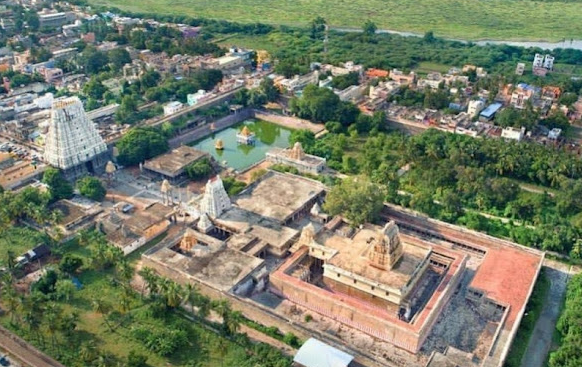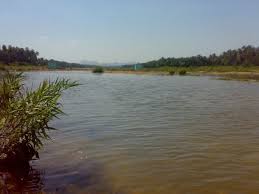- Varadaraja Perumal Temple is one of the celebrated places of worship of Lord Vishnu. Hailed also as including Thirukkachi and Hastigiri in many scriptures and literary works, it remains a Divyadesam that the Azhwar saints have sung about, in their sacred hymns.
- This is also one of the 3 most sacred Vishnu shrines and is referred to in the Vaishnava parlance as 'Perumal Koil,' with the other 2 being Srirangam known as 'Koil,' and Tirupati, as 'Tirumalai.'
- This temple is located in the ancient and historical temple-town of Kanchipuram in Tamil Nadu.
- The part of the town where this temple is situated itself is known as Vishnu Kanchi, in view of the presence of this temple and some others, dedicated to Vishnu.
- The original moola moorthy (moolavar) is Athithi Varadar, who was consecrated by Lord Brahma himself, is kept inside a silver basket and kept inside the temple tank - Ananda saras and taken once in every 40 years. Last time, he was taken out in 2019 and next would be 2059 and so on.
- The temple itself is on top of Hastigiri hill, which is believed to be Indra's elephant Airavata. There is a hall of 100 pillars and the sculptures on each pillar are stunning.
- Stories and legends from Hindu mythology are depicted. Once in 40 years, the holy tank, Anantha theertham is emptied and a wooden idol of Lord Attigiri Varadaraja is taken out from under and worshipped by millions.
- This is one of the old temples and believed to be more than 2000+ years old. Out of 108 divya desams of Lord Vishnu, The "Malai" is referred for Thirupathi, and "Koil" is referred to Srirangam and "Perumal Koil" is referred to this Varadaraja Perumal Koil. Out of 108 divya desams, this is referred to as the 43rd divya desam.
- The name "varadar" means to give blessings to all, hence the main deity is termed as Varadarajan.
- The history of this temple goes like , Lord Brahma wanted to see Vishnu with his four arms and went into penance. He heard a voice directing him to do 100 aswamedha yagam.
- Lord Brahma was surprised and felt sad since 1 yaga itself will take several years. Again the divine voice directed Lord Brahma to visit Kanchipuram and requested him to do 1 aswamedha yaga which will be equal to 100 yagas due to the divine nature of the place.
PURANIC SIGNIFICANCE 1:
- There are a few mythological stories about this temple, most of them involving Goddess Saraswati.
- Indra, the king of the celestials, was once cursed by Saraswati to become an elephant, but he was relieved of his curse by Vishnu's grace, here.
- Hastigiri means the elephant-hill, and Indra is said to remain as the Hastigiri hillock on top of which the Lord is enshrined.
- As per another story, Brahma performed a sacrifice here, but his consort Saraswati, who had some misunderstanding with him, came in the form of a flooding Vegavathi river to wash away the Yagya.
- But Vishnu laid himself on the path, halted the floods, and ensured the successful completion of the sacrifice.
- This Vegavati of the legends is said to be the Palar river, of the present times.
- He is also said to have emerged as Devaraja Swamy with the brilliance of innumerable Suns from the sacrificial fire and stayed here.
- As he came out of the fire, the face of the processional deity bears many scars on it. It is also said that 2 of sage Gautama's disciples incurred a curse and turned into lizards.
- They worshipped the Lord of this temple and were relieved of their afflictions.
- 2 lizards can still be found in the temple roof as if to bear testimony to this legend.
PURANIC SIGNIFICANCE 2:
- Thirumangai Azhwar spent all his wealth and taxes towards the building of the temple and the king punished him for not paying the taxes and losing wealth of the kingdom.
- A divine voice informed the king in his dreams that he can pick up wealth from a nearby place and relieve Thirumangai Azhwar.
- Thirukachi Nambi was an ardent devotee of Varadraj.
- He used to come a long way everyday to the temple to offer his worship. During his old age, he was privileged to converse with god. Ramanuja, the preceptor of Vishishtadvaita philosophy, was tricked by his master and was plotted to be killed. But by the grace of divinity, he was masked as a hunter and escaped the event. He later came back to the temple to make the Vaishnava philosophy.
Brihaspathi’s curse
- A debate took place in the court of the Devas as to which was more worthy – ‘Family life’ or 'Life of a Sanyasi’. When they could not come to a conclusive answer, the Devas looked to their preceptor, Brihaspathi for a final decision. Brihaspathi pronounced that Sanyasin was better.
- Angered at this decision of not recognizing the difficulty of family life, Indra cursed Brihaspathi to become a poor Brahmin with children.
- Leading this life, Brihaspathi one day chased away a hungry dog which had come inside his house and was cursed for not providing refuge to a hungry animal.
- And he was turned into a dog.
- The Devas, by now, were feeling the absence of their preceptor.
- When Indra approached Brahma to help get Brihaspathi back amongst them, he was asked to accompany Brahma to ThiruKachi where Brihaspathi was already undertaking a penance before Varadaraja Perumal.
- Answering their prayers, Lord Varadarajan is said to have given Brihaspathi his original status and form.
Lord Varadarajan Saves Ramanuja
- Aalavanthaan met Ramanuja for the first time here in Kanchipuram.The story goes that Ramanuja once lost his way in the Vindhya forest.
- Lord Varadarajan is said to have appeared as a hunter and carried Ramanuja all the way to Kanchipuram.
- A tired Varadarajan (the hunter) asked Ramanuja for water. When Ramanuja brought water from the street well, he is said to have seen Lord Varadarajan, along with the Goddess, disappear right in front of him into the temple sannidhi.
- To this day, sacred water for Lord Varadarajan is brought from this street well.
The story-Brahma completes Ashwametha Yaagam
- Brahma wanted to see Lord Vishnu, on earth, in his full form.
- He undertook penance and the Lord appeared in the form of water in Pushkaram and in the form of forest in Naimisharanya.
- He was then asked to do Ashwametha Yagam at ‘Sathya Kshetram’.
- It was here in Kanchipuram that Brahma performed the Ashwametha Yaagam.
- As seen in the earlier Divya Desam stories (relating to Kanchipuram), Saraswathi was angry that Brahma undertook the Yaagam without her support and presence and adopted different ways to stop the Yaagam.
- Lord Vishnu took different forms to thwart her attempts.
- At ThiruVekka, he stopped river VegaVathi by sleeping across as a dam, at Ashtabujam he came with 8 hands to kill the asura and subdue Kaali, at Thiru Thanka, he appeared as a flame to provide light (after Saraswathi had plunged the place into darkness).
- Finally, Lord Vishnu is said to have landed here in his Punyakoti Vimanam and appeared before Brahma to signal the completion of the Ashwametha Yaagam.
- One finds the Azhagiya Singar (Lord Narasimhar) Sannidhi on the way to Varadaraja Perumal Sannidhi.
- 24 steps from the Eastern side(entrance) leads one to the Prakaram of the Varadaraja Perumal.
- Once into the Sannidhi, another few steps takes one to the tall standing posture of VaradarajaPerumal, seen facing the West.
Brahma visits Lord Varadarajan once a year
- Belief is that Brahma comes here once a year on the full moon day in the Tamil month of Chithirai (April-May) -around midnight- for a darshan of Varadarajan.
- On this day, it is the practice for the priests to place food inside the sanctum and to wait outside for 24 minutes.
- At the end of this, the food is said to smell sweeter.

